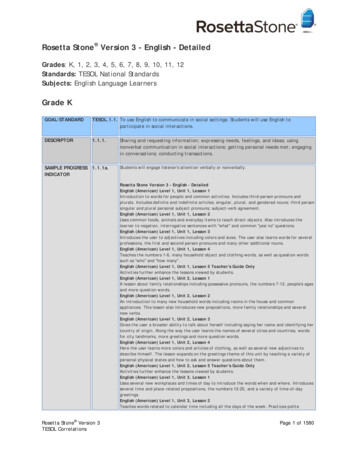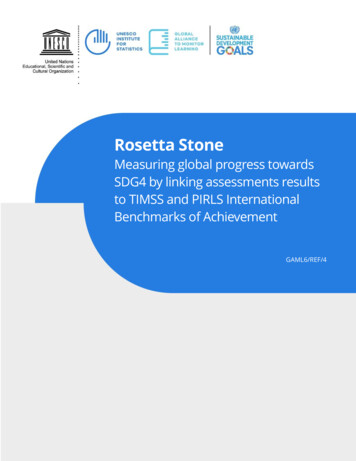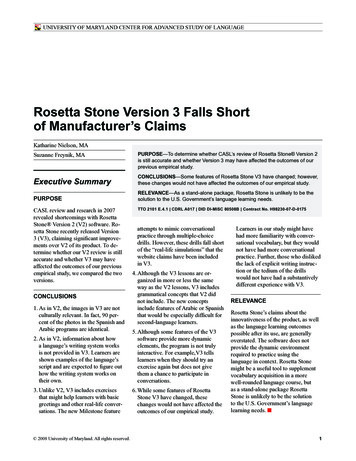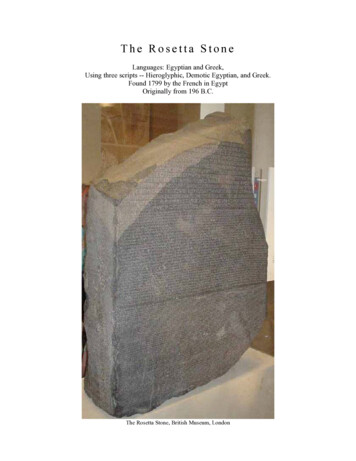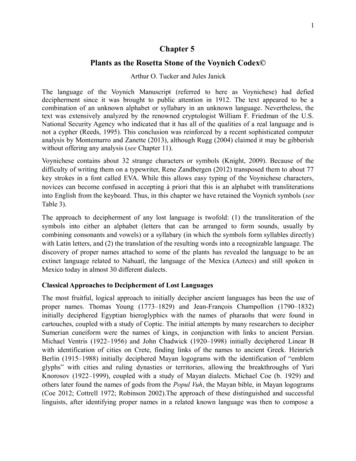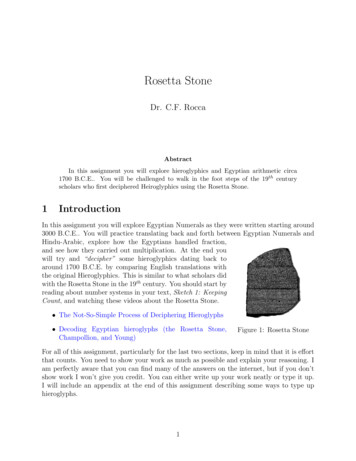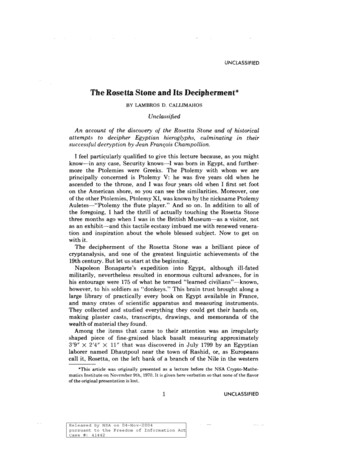
Transcription
UNCLASSIFIEDThe Rosetta Stone and Its Decipherment*BY LAMBROS D. CALLIMAHOSUnclassifiedAn account of the discovery of the Rosetta Stone and of historicalattempts to decipher Egyptian hieroglyphs, culminating in theirsuccessful decryption by Jean Frani;ois Champollion.I feel partic;ularly qualified to give this lecture because, as you mightknow-in any case, Security knows-I was born in Egypt, and furthermore the Ptolemies were Greeks. The Ptolemy with whom we areprincipally concerned is Ptolemy V: he was five years old when heascended to the throne, and I was four years old when I first set footon the American shore, so you can see the similarities. Moreover, oneof the other Ptolemies, Ptolemy XI, was known by the nickname PtolemyAuletes-"Ptolemy the flute player." And so on. In addition to all ofthe foregoing, I had the thrill of actually touching the Rosetta Stonethree months ago when I was in the British Museum-as a visitor, notas an exhibit-and this tactile ecstasy imbued me with renewed veneration and inspiration about the whole blessed subject. Now to get onwith it.The decipherment of the Rosetta Stone was a brilliant piece ofcryptanalysis, and one of the greatest linguistic achievements of the19th century. But let us start at the beginning.Napoleon Bonaparte's expedition into Egypt, although ill-fatedmilitarily, nevertheless resulted in enormous cultural advances, for inhis entourage were 175 of what he termed "learned civilians" -known,however, to his soldiers as "donkeys." This brain trust brought along alarge library of practically every book on Egypt available in France,and many crates of scientific apparatus and measuring instruments.They collected and studied everything they could get their hands on,making plaster casts, transcripts, drawings, and memoranda of thewealth of material they found.Among the items that came to their attention was an irregularlyshaped piece of fine-grained black basalt measuring approximately3'9" X 2'4" X 11" that was discovered in July 1799 by an Egyptianlaborer named Dhautpoul near the town of Rashid, or, as Europeanscall it, Rosetta, on the left bank of a branch of the Nile in the western*This article was originally presented as a lecture before the NSA Crypto-Mathematics Institute on November 9th, 1970. It is given here verbatim so that none of the flavorof the original presentation is lost.1Released by NSA on 04-Nov-2004pursuant to the Freedom of Information Actcase #: 41442UNCLASSIFIED
UNCLASSIFIEDROSETTA STONEdelta, about 30 miles from Alexandria. One side of the slab was polished, and bore inscriptions in three scripts. Dhautpoul showed it tothe officer in charge of the laborers, a Captain Pierre-Frarn;oisBouchard, who became quite excited-all Frenchmen get excited atthe drop of a hat. He saw the possibility of the three scripts being threeversions of the same text, and since the first one was in hieroglyphsand the last one obviously in Greek which could probably be read, herealized that this find might well be the key to unlocking the secrets ofthe hieroglyphs.News of the Rosetta Stone, as it came to be called, spread like wildfire, and shortly thereafter it was sent to Cairo and deposited in therecently founded lnstitut National. In Cairo, the Stone became anobject of greatest interest to Napoleon's intellectual contingent, andhe himself exhibited great curiosity as to the contents of the inscriptions. One of his generals, who happened to be a Greek classicist byavocation, translated the Greek inscription and found that it was adecree issued in 196 B.C. by a gathering of Egyptian priests in Memphis, praising Ptolemy V Epiphanes for the benefits he had bestowedon his people. The middle inscription was recognized as Egyptiandemotic, which is a modified form of the hieratic or cursive form ofhieroglyphic writing and which, like the hieroglyphs themselves, wasa mystery. Napoleon ordered ink impressions made of the inscriptions,and had copies sent to prominent scholars in various parts of Europe.When the French were defeated in Egypt in the spring of 1801, ArticleXVI of the Treaty of Capitulation stipulated that the Rosetta Stoneand certain other large and important antiquities were to be surrendered. But soon after the ink impressions were made from the RosettaStone, the Stone was taken from Cairo to the home of a French generalby the name of Menou, who promptly assumed the attitude that itwas his own private property. The Stone was dislodged from theclutches of General Menou in October, and it arrived in England inFebruary 1802. It was displayed briefly in the Society of Antiquaries inLondon where the inscriptions were examined by scholars. Casts weremade for the Universities of Oxford, Cambridge, Edinburgh, andDublin, and at the end of the year George ill decreed that the RosettaStone be transferred to the British Museum where it still remains,displayed in its permanent location at the southern end of the EgyptianSculpture Gallery. George III may have lost a country, but he gaineda Stone.The top right- and left-hand corners, and the bottom right-handcorner of the Rosetta Stone are missing, and judging from the proportion of the lengths of the inscriptions that are on it, when the Stonewas intact it was at least 12" longer than it is now. Furthermore, sinceit was probably a part of a sculptured decoration, when the Stone wasUNCLASSIFIED2rLfc-
L. D. CALLIMAHOSUNCLASSIFIEDin its complete state it must have been 5 or 6 feet high, mounted near astatue of the king in whose honor it was inscribed. The Rosetta Stone isa bilingual in that two languages, Egyptian and Greek, are present inthe inscriptions. The top part consists of 14 lines of Egyptian hieroglyphics with missing beginning and ending portions, in addition to anunknown number of missing lines; the middle part consists of 32 linesof Egyptian demotic, almost half of them incomplete; and the bottompart consists of 54 lines of Greek text, 26 lines of which have missingportions at their ends.An English translation of the Greek text was made by a man of thecloth, the Reverend Stephen Weston, and read by him before theSociety of Antiquaries of London in April 1802. Translations intoFrench and Latin appeared in Paris at about the same time. It wasclear that the three texts were almost identica], with the originalGreek version being repeated in "the writing of the speech of the god"and in "the writing of the books," which were the phrases used todescribe the hieroglyphic and demotic texts. Early attempts at decipherment concentrated on the demotic, because the cursive signswere taken to be alphabetic since they seemed to bear a similaritywith Arabic, and furthermore because the demotic text was practicallycomplete. In that same year, 1802, the oriental scholar Sylvestre deSacy succeeded in recognizing several names, including that ofPtolemy, by a comparison with the Greek text. But even with thisassistance, he was unable to reconstruct what he thought should be analphabet and he forthwith declared the problem to be unsolvable.The talented Swedish diplomat John David Akerblad took over theresults from de Sacy's work and was able to identify in the demoticversion every one of the proper names which occurred in the Greekversion, together with a few other words, all of which proved to havebeen alphabetically written. He naturally assumed that the demoticwas strictly alphabetic throughout, and this erroneous assumptionstopped all further progress on his part.The next 10 years saw a series of so-called "decipherments," mainlyof the demotic, by charlatans, mountebanks, hop-heads, and justplain fakers. This tendency was nothing new, since the renownedJesuit scholar Athanasius Kircher had published, in the early 1650's,four volumes of "translations" of hieroglyphs, not one of which had theslightest foundation in fact. For example, the group of signs whichreally stood for the title "Autokrator" he translated as "The creatorof all vegetation and fruitfulness is Osiris, whose generative force holyMophta draws into his kingdom from heaven." (Holy Mophta!) Achap by the name of de Guignes read a paper before the Paris Academy of Inscriptions, asserting that, on the basis of comparative hieroglyphology, the Chinese were Egyptian colonists. Another chap, the3UNCLASSIFIED
UNCLASSIFIEDROSE'ITA STONE.Count N. G. de Palin, claimed to be able to read the Rosetta Stoneat sight, saying that speed of attack had "preserved him from thesystematic errors that must arise from excessive contemplation." (Itmight be worthwhile to pause for a moment and contemplate ournavels as we mull over this last sentence-and notice how I studiouslyavoided the word "omphaloskepsis.")Most scientists and scholars were convinced of the indecipherabilityof the hieroglyphs. The first contribution was made by the GermanDanish archaeologist Georg Zoega in the late 18th century, who recognized that the names of Egyptian monarchs in hieroglyphic writingswere surrounded by an oval ring, or what is now called a cartouche.The first significant contribution, however, was made by ThomasYoung, the English physicist, when he obtained a copy of the RosettaStone in 1814. He determined that the hieroglyphs were to be readfrom right to left, by noting the direction in which the birds and animals faced in the pictorial script, and he rationalized that if a systemof writing had to mention a foreign name, it must be done so phonetically. He thereupon identified the name Ptolemy with the cartouchediscovered by Zoega, but his analysis of the component hieroglyphswas incorrect, including the assumption of a convenient null ormeaningless symbol. Young, a brilliant scholar, was a fluent reader bythe time he was two years old, and by the time he was 20 he was versedin a dozen languages including Arabic, Ethiopic, Persian, andTurkish. At the age of 25 he received a large inheritance from anuncle, and his resulting financial independence left him free to pursuevaried intellectual interests, including the love-life of spiders. ToYoung must go the credit of showing that hieroglyphs must possessalphabetical values, a conjecture made by earlier scholars; nevertheless, as already mentioned, his alphabetical assignment to specificcharacters was in error. Young gave up at this point, remarking thatthe discovery of the meanings of remaining signs would follow alongthe general lines he had already indicated. It is certainly curious whyhe stopped, however, ifthe matter were that simple.Now we come to our hero. Jean Frarn;ois Champollion was born onDecember 23, 1790 at Figeac in the Department du Lot in France. Hewas a child prodigy like Thomas Young, and at 5 years of age he taughthimself to read by comparing a list of words he had learned by heartwith the text he was reading. He did poorly in school in Figeac, however, so in 1801 his brother Jacques-Joseph, 12 years his senior, tookhim to Grenoble and there supervised his education. Jacques-Josephwas a gifted philologist in his own right, and keenly interested inarchaeology: at one time he was to have accompanied Napoleon'sexpedition into Egypt. When, however, the IO-year-old Champollionshowed a remarkable talent for Greek and Latin, and took up HebrewUNCLASSIFIED4
L. D. CALLIMAHOSUNCLASSIFIEDJean Fram;ois Champollion (1790-1832)with astonishing success, his brother, with the modesty and selfsacrifice of a saint, resolved to devote his life to the furtherance ofJean Fran ;ois' career in place of his own: he thereupon called himselfChampollion-Figeac, and his younger brother returned the compliment by calling himself "Champollion le Jeune," to remind theworld that there was another Champollion to be reckoned with. Thatsame year, in 1801, the famous mathematician and physicist, JeanBaptiste Fourier, encountered the IO-year-old Champollion in hisGrenoble school and was immediately impressed with the lad'ssuperior intelligence. He invited him to his house, where he showedhim his collection of Egyptian antiquities, including papyri and stonetablets. Champollion asked Fourier whether anyone had succeeded indeciphering the hieroglyphs, and upon receiving a negative answer,he announced: "I am going to decipher them. When I am big."Thus began a lifelong fervent dedication on the part of this intenseyouth, whose oriental-looking eyes and sallow complexion later gavehim the nickname of "The Egyptian." But in order to prepare himselffor the pursuit of his ambition, he felt he first had to arm himself withall necessary background knowledge. When he was 13 he began tolearn Arabic, Syrian, Persian, Chaldean, Sanskrit, and finally Coptic,which was the only language providing a link with the Old Egyptian.At the age of 16, he drew up the first historical chart of the kingdom ofthe Pharaohs, using spotty Arabic, Latin, and Hebraic texts andcomparisons with the Coptic; and when he was asked by his school towrite a paper on a subject of his own choosing, he drafted an outline of5UNCLASSIFIED
UNCLASSIFIEDROSETTA STONEa book, "Egypt under the Pharaohs." He read the introduction to hisprojected work before the entire faculty of his Grenoble high school,and they were so overwhelmed that he was made a member of thefaculty on the spot, not only for his accomplishments to date, but alsofor the undeniable promise of future scholarly achievements.When Champollion was 17, he was taken by his brother to Paris tostudy under Sylvestre de Sacy, Figeac's former teacher. De Sacy sawthe boy's genius and disliked him from the start; although it was hewho first acquainted Champollion with the Rosetta Stone, he tried todissuade him from attempting to decipher the hieroglyphs. In Paris,Champollion immersed himself in his studies, and was able, throughthe intercession of his brother, to escape Napoleon's draft. Nevertheless, Champollion got into hot water with the authorities over hispolitical convictions, and for a year and a half he was banned from theuniversity for traitorous activities. Incidentally, Champollion hadalready met Napoleon under his brother's auspices, and Napoleontoo came under the spell of the boy's apparent genius. In 1821 newcharges of treason loomed and Champollion, now a professor at theuniversity, took off from Paris like an Egyptian cat being pursued byOsiris.In the meantime, Champollion had tackled the Rosetta Stonewithout much success, since he was under the initial conviction thatthe hieroglyphs represented things and concepts, and not sounds.However, on December 21, 1821, when he counted the hieroglyphs andfound there were 1419 of them, as compared with the 486 words in theGreek text, he realized that the hieroglyphs had to represent alphabetic or phonetic elements. He knew that the sixfold occurrence ofthe same cartouche (with slight modifications) stood for Ptolemy, butthis was not enough: he needed different names or words on which tocheck the putative values derived from the assumption of Ptolemy.The Rosetta Stone by itself did not suffice, and he needed additionalsupport from another quarter. This was provided, most fortunately,by a granite obelisk with bilingual text in Greek and hieroglyphics,found at Philae in 1815 by the English archaelogist W. J. Bankes, whocontrived to have it shipped in 1821 to his home at Kingston Lacy, inDorset, where the obelisk was re-erected. On September 27, 1822,Champollion communicated to the Academy of Paris his now famous"Lettre a M. Dacier relative a l'alphabet des hieroglyphes phonetiques,"informing the world of his successful decipherment of the Egyptianhieroglyphs.In the Greek portion of the Philae obelisk there appear the namesof Ptolemy and Cleopatra, and in the hieroglyphic portion there are twocartouches which should represent the Egyptian equivalents for thesenames. The cartouche in the obelisk containing the name PtolemyUNCLASSIFIED6
L. D. CALLIMAHOSUNCLASSIFIEDis almost identical with the cartouche known to represent Ptolemy inthe Rosetta Stone, as we can see from the following in which, for convenience, the order of hieroglyphs has been reversed so that they may beread from left to right:On the Rosetta Stone( fl -:;; f ]])rOn the Obelisk from Philae ( fl rf iJJEElIt will be noted that the final sign JEEl in the Philae cartouche is of the Rosetta Stone carequivalent to the last three signstouche. Now the Philae cartouche representing the name of Cleopatrais the following:Let us now juxtapose the Philae cartouches containing the names ofPtolemy and Cleopatra, stringing out the hieroglyphs and numberingthe signs, as follows:'" " "R ,.' {) nn n .Q. :'-.r oa1:t :i: :tlA ( oa:1!'(.2!::16c:: " "i1l,'I Ptoemy,.Cleopatra, B. Q k. · fl · · :: )We can see that No. 1 in A and No. 5 in Bare identical, and that fromtheir positions in the two names they must represent the letter P. No. 4in A and No. 2 in Bare identical, and again from their positions in thetwo names they must represent the letter L. And since L is thesecond letter in the name Cleopatra, the first sign in B must representthe letter K (in the Greek spelling of the name). Thus far in Cleopatra'scartouche-my, that sounds odd-we have the following substitutions:Since in all probability the name Cleopatra would be phoneticized inthe Greek fashion, this then would mean that sign No. 3 represents anE, and sign No. 4 represents an 0. Signs Nos. 6 and 9 are identical, sothey must be the two A's in Cleopatra, leading to the recovery of No. 7as T and No. 8 as R. Signs Nos. 10 and 11 always followed the name of agoddess, a queen, or a princess, so they must be simply a determinative after the names of females. Cleopatra's cartouche is thus completely deciphered, with the added observation that since in someforms of the cartouche the sign No. 7 has been replaced by sign No. 10,it may be assumed that these two signs have the same sound, namely,that of a T.7UNCLASSIFIED
UNCLASSIFIEDROSEITA STONEWhen we now substitute the values derived from the analysis ofCleopatra's cartouche into their corresponding signs of the cartoucheknown to contain the name Ptolemy, we have the following:In addition to the emergence of the obvious beginning of the namePtolemy, we see that there are many other hieroglyphic symbols to beaccounted for which are not part of Ptolemy's name. There are anumber of variations in the form of Ptolemy's cartouche, the simplestof them being the following:It can therefore be inferred that signs Nos. 8 through 14 represent theroyal titles found in the Greek text of the Rosetta Stone meaning"ever-living, beloved of Ptah." The Greek form of Ptolemy isPtolemaios, ending with an S, so we can assume that sign No. 7 inthe simplest form of the cartouche represents the phonetic value ofan S. This leaves only two signs to be accounted for, so sign No. 5must represent an M sound, and sign No. 6 must be a vowel soundcorresponding to the Greek diphthong m.The values thus far derived may be applied to other cartouches suchas the following:The first cartouche deciphers at once to "Pilatra" which, to a classicist,is obviously the Greek name "Philotera." The second cartouche isonly partially decipherable, as follows:(AL" 'S TR-lOf the four signs not yet accounted for, the third was already knownto represent the sound N in the name Berenice, and the fourth signhad been found as the last element of the Greek title "Kaisaros," i.e.,"Caesar" or "emperor," so it must be an S sound. Since the first signhas sometimes been the first symbol in a cartouche for Cleopatra,it must be a variant for a K sound. Inserting these values into thesecond cartouche, we have the following:(ALI.SqNTJlS)The name "Alexandros" or "Alexander" is now revealed, and in theprocess we recover the value of the hitherto-unequated signas avowel with the sound of an A or E.UNCLASSIFIED8
L. D. CALLIMAHOSUNCLASSIFIEDGoing back to the signs which we had assumed should represent theroyal titles "ever-living, beloved of Ptah," we will now check the validity of our assumption. The old Egyptian word for "life" and "living"was known, both from tradition and from the Coptic, to be "ankh" or"ankh," and this was represented by the sign Sf- several times in theinscriptions. It was then guessed that the triple sign meant"ever." Again, it was known from the Coptic that one of the oldEgyptian words for "ever, age, eternity" was djet, and since we knowthat the middle part of the triple sign has a phonetic value of T, we canassume that the first part 'I of the triple must represent the sounddj. The last part of the triple sign is a determinative, which was notpronounced. Thus the first titlef means "living ever," or"ever-living." Of the remaining signs · """"', the first two wehave already analyzed as P and T, which are the first two letters in thename Ptah; the third sign must have a value similar to an H.The last sign, the one following the name ah, should mean "loving"or "loved." Once again a knowledge of Coptic comes to the rescue, andthis sign is read as "mer," from the Coptic word "mere," to love. Bycontinuing this process, comparing texts containing variant forms,and by a masterful application of his knowledge of Coptic, Champollion succeeded in the decipherment of the Egyptian hieroglyphs.The foregoing steps, simple as they are cryptanalytically, were butthe initial entries into the decipherment of the hieroglyphs. Champollion's tremendous achievement and magnificent feat of the subsequentdecipherments, culminating in the reconstruction and writing of themonumental first grammar of the ancient Egyptian tongue, cannot beoveremphasized. Although Champollion had his detractors during hisdays, he was vindicated by the discovery in 1866, 34 years after hisdeath in 1832 at the age of 41, of another bilingual inscription, thelengthy "Decree of Canopus," the reading of which gave absoluteconfirmation of all the steps of his entire system of decipherment.9UNCLASSIFIED!.
a Stone. The top right- and left-hand corners, and the bottom right-hand corner of the Rosetta Stone are missing, and judging from the propor tion of the lengths of the inscriptions that are on it, when the Stone was intact it w

